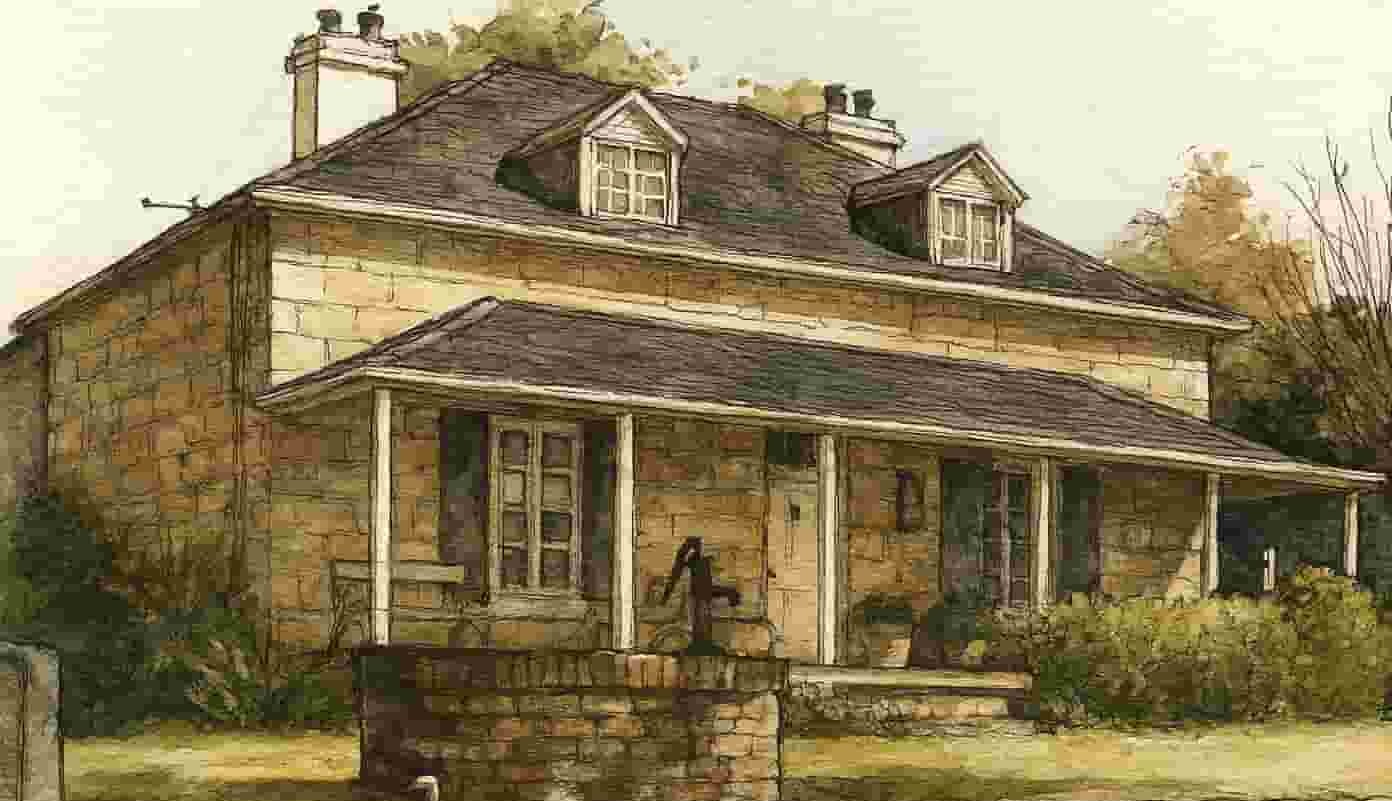James John Cadell
Hunter Valley Medical Practitioner
James John Cadell came from the coal mining district of Grange Boness, Scotland. He sailed from Greenock on 25 October 1839 on the Portland and arrived in Sydney on 7 February 1840. Surgeon Superintendent on the Portland was Ellar McKellar McKinlay.
Cadell Cottage
 He was living in Kent Street, Sydney at the time of his marriage to Catherine Cadell on 21 July 1841 and by 1845 had purchased land from James King at Raymond Terrace. Here he built 'Cadell Cottage', a sandstone house with a nine foot verandah running the full width of the house.
He was living in Kent Street, Sydney at the time of his marriage to Catherine Cadell on 21 July 1841 and by 1845 had purchased land from James King at Raymond Terrace. Here he built 'Cadell Cottage', a sandstone house with a nine foot verandah running the full width of the house.In September 1848 he had the unpleasant duty of informing the parents of two year old Mary Carney that their daughter would not survive. Mary, who just a year older than Dr. Cadell's eldest daughter Isabella, had been run over by the wheel of her parent's bullock dray as they were entering the yard of their Miller's Forest property. The wheel of the dray knocked Mary over and passed over her chest. The distraught parents rushed her to Dr. Cadell at Raymond Terrace but there was nothing he could do as internal organs had been ruptured and he advised them to take her home immediately.
Family
John James and Catherine Cadell produced eleven children - Catherine, James, John, William, Mary Buchan, Christian, Agnes Alison, Harriett Ann, Henry, Charles and Martha LilleeCatherine Cadell died of typhus fever in April 1862 aged 40. Following her death James Cadell married Elizabeth Cahill and had four more children: Julia, Francis Augustus, Lewis, and Alfred Boyd Cadell.
Tamworth
Later he moved to the Tamworth district -The Laird of Deepwater is a biography of William Cadell the son of J.J. Cadell -
LAIRD OF DEEPWATER.' An Interesting Personality. A copy of the 'Scottish Australasian'' to hand, under the title of 'The Scot We Know,' contains a biographical sketch of William. T. Cadell, the 'Laird of Deepwater,' accompanied by an excellent portrait and a piece of family tartan. Mr. Cadell, it is explained, is the descendant of a good old Covenanter, who was a man of importance soon after the Reformation.
His father, was Dr. Cadell, who sailed in 1839 for the little known colony, of New South Wales, where he married and settled at Raymond Terrace, on the lower Hunter River, where 'the Scot we know' was born in July, 1845.
After a successful career as a medical practitioner, Dr. Cadell, the father of the subject of, these remarks, states the biography, purchased or took up the mountainous and unfenced: station of Dungowan, near Tamworth, and began pastoral pursuits in this (at that time) outpost of civilisation where horse mail was delivered once a week, when possible.
Meanwhile, his son was being educated at Raymond Terrace, and at Windsor, on the Hawkesbury River, and when 16 years of age he began his life's work on his father's station, and there became deeply learned in the cults of horse, cattle, and sheep, and all kinds of strenuous bush work. In these early days native wild dogs, or dingoes, enjoyed a high old time among .sheep and lambs on those unfenced mountain stations, and sorely tried the patience and skill of the shepherds, as well as the pockets of the squatters.
Mr. Cadell followed his calling here for 14 years, during which time he married the daughter of the Hon. J. D. Macansh, a large squatter on the Darling Downs. The ambitious and brave young couple determined to paddle their own canoe, and to this end sought 'fresh fields and pastures new.'
In 1875 they crossed the Moonbi Ranges, and the pastoral plains of Armidale, over the snow-covered plateau of Ben Lomond, across the rich, black soil plains of Glen Innes, where Highlandmen had already settled, and to Deepwater Station, where 30 years before Thomas Windeyer, a man of iron will and undaunted courage, had formed a station surrounded by hostile natives. Here W.T. Cadell halted - bargained for, and finally took possession of the station with 13,500 sheep and 2200 cattle. The history of Deepwater Station through the whole of the intervening years is a tale of high ideals realised, enduring endeavour, and a long battle nobly and bravely fought.
From the day of his entry Mr. Cadell's one purpose has been to breed only, and to own, the very best and finest classes of sheep and cattle, and in this he has been singularly successful. 'Deepwater cattle, sheep and wool command the highest market prices. They top the markets for weight, quality and price, and this is solely duo to the unremitting care and personal attention, the courage, and masterful management and profound knowledge of the owner. The biography pays a warm tribute to Mr. Cadell's personal worth, and refers in similar strain to his wife, 'an amiable lady of cultivated tastes, and of rare intelligence and worth, who indeed has contributed no insignificant part to the success and the wide popularity of the 'Laird of that ilk.' where unstinted hospitality and the warmth of the traveller's welcome is proverbial.'[2]
Death
James John Cadell died at Raymond Terrace in 1884 [3]References
[1] The Sydney Gazette and New South Wales Advertiser (NSW : 1803 - 1842) Sat 8 Feb 1840[2] The Tamworth Daily Observer (NSW : 1910 - 1916) Fri 20 Nov 1914
[3] The Maitland Mercury and Hunter River General Advertiser (NSW : 1843 - 1893) Thu 21 Feb 1884
↑
